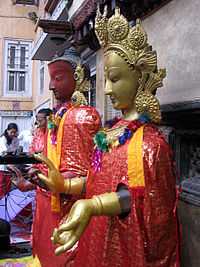Gunla
 Statues of Dipankara Buddha on display during Gunlā in Kathmandu | |
| Also called | Gunlā Parva in Nepali |
| Observed by | Nepalese Buddhists |
| Type | Religious |
| Significance | Celebrates rains retreat started by the Buddha |
| Observances | Image displays, musical processions, alms distribution, fasting, prayer |
| 2014 date |
27 July - 26 August Gunlā 3 August Panjarān (alms giving) in Lalitpur 7 August Bahidyah Bwayegu (Buddha display) 10 August Gunhi Punhi (Full Moon Day) 12 August Matayā (procession) 23 August Panjarān (alms giving) in Kathmandu |

Gunlā (Nepal Bhasa: गुंला) (also spelt Gumlā) is a holy month for Newar Buddhists when they recite the scriptures, observe fasts and visit places of worship playing devotional music. It is one of the most important events in Newar Buddhism.[1] [2]
Gunla is the name of the tenth month in the Nepal Sambat lunar calendar, which roughly corresponds to August of the Gregorian Calendar.
The practice of observing the sacred month is descended from the rains retreat dating from the Buddha's time when monks stayed in one place and taught the Dharma.[3] [4]
Observances
Devotees mark the holy month by making daily early morning pilgrimages to Swayambhu in Kathmandu and other Buddhist temples playing Gunla Bajan music. The musical bands represent various localities of the city.
The devout recite the scriptures at home and sacred courtyards. Some undergo fasting. Another devotional activity during Gunla is Dyah Thāyegu (द्यः थायेगु) when devotees make little stupas out of black clay using a mold.[5]
Major days
Panjarān
Panjaran (पन्जरां) is the alms giving festival. Males of the Bajracharya and Shakya castes make an alms round of the city and devotees give them rice and money. Shrines are set up with Buddha statues and paubha scroll paintings at private homes, courtyards and on the roadsides from where the gifts are distributed. The event is held on different dates in Kathmandu and Lalitpur.
Buddha display
On the first day of the second fortnight of Gunla, large images of the Dipankara Buddha and paubha paintings are put on display in sacred courtyards. The ceremony is known as Bahidyah Bwayegu (बहीद्यः ब्वयेगु).[6]
On this day in a festival known as Bahidyah Swahwanegu (बहीद्यः स्वःवनेगु), the musical bands followed by residents of the locality visit the sacred courtyards in a procession to view the exhibits. The festival occurs on the day after the full moon and coincides with the Gai Jatra festival.
Another major day for Gunla Bajan societies is the ceremony of Nisala Chhawanegu (निसला छाःवनेगु), when they make offerings to Swayambhu, and hold Gunla Bajan concerts at one's neighborhoods.
Matayā
Matayā (मतया:) (meaning "light procession" in Nepal Bhasa) is one of the most important religious celebrations in Lalitpur. The festival celebrates the event when the Buddha overcame Mara, or temptation, and attained the light of wisdom.[7]
Devotees visit Buddhist shrines and sacred courtyards in the city in a winding file and offer worship to the images. The participants also consists of musical bands and actors dressed in colorful costumes. The circuitous festival route takes the whole day to complete.[8]
See also
References
- ↑ Locke, John K. (2008). "Unique Features of Newar Buddhism". Nagarjuna Institute of Exact Methods. Retrieved 5 August 2012.
- ↑ Lewis, Todd T. (January 1996). "Notes on the Uray and the Modernization of Newar Buddhism". Contributions to Nepalese Studies. Retrieved 5 August 2012. Page 111.
- ↑ LeVine, Sarah and Gellner, David N. (2005) Rebuilding Buddhism: The Theravada Movement in Twentieth-Century Nepal. Harvard University Press. ISBN 978-0-674-01908-9. Page 64. Retrieved 5 August 2012.
- ↑ Lewis, Todd T. (Winter 1993). "Contributions to the Study of Popular Buddhism: The Newar Buddhist Festival of Gumla Dharma". Journal of the International Association of Buddhist Studies. Retrieved 19 February 2013. Page 323.
- ↑ Lewis, Todd T. (Winter 1993). "Contributions to the Study of Popular Buddhism: The Newar Buddhist Festival of Gumla Dharma". Journal of the International Association of Buddhist Studies. Retrieved 19 February 2013. Page 333.
- ↑ Lewis, Todd T. (Winter 1993). "Contributions to the Study of Popular Buddhism: The Newar Buddhist Festival of Gumla Dharma". Journal of the International Association of Buddhist Studies. Retrieved 19 February 2013. Page 335.
- ↑ Shakya, Min Bahadur (3 August 2012). "Mataya Festival of Patan". Yalamandu Post. Retrieved 17 July 2013.
- ↑ Lewis, Todd T. (Winter 1993). "Contributions to the Study of Popular Buddhism: The Newar Buddhist Festival of Gumla Dharma". Journal of the International Association of Buddhist Studies. Retrieved 10 July 2013. Page 317.
| |||||||||||||||||||||||||||||